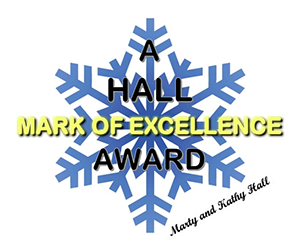 This coverage is made possible through the generous support of Marty and Kathy Hall and A Hall Mark of Excellence Award. To learn more about A Hall Mark of Excellence Award, or to learn how you can support FasterSkier’s coverage, please contact info@fasterskier.com.
This coverage is made possible through the generous support of Marty and Kathy Hall and A Hall Mark of Excellence Award. To learn more about A Hall Mark of Excellence Award, or to learn how you can support FasterSkier’s coverage, please contact info@fasterskier.com.
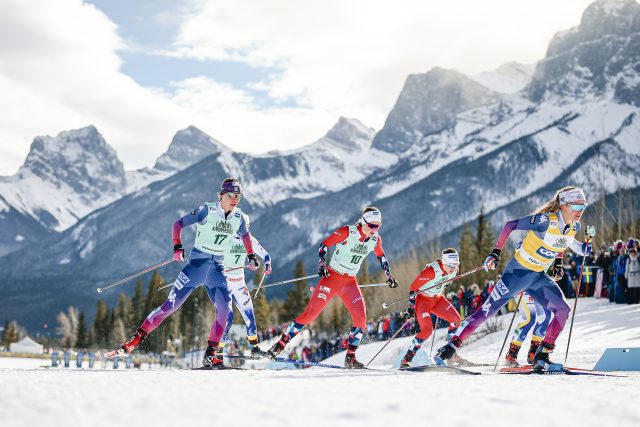
Canmore, Alberta features a World Cup Sprint course that climbs right from the start, two back-to-back inclines that would produce lactic acid and technical challenges if anyone chose to sprint up them. Almost no one did. The nature of Canmore’s Sprint course is such that those climbs barely reward the effort to lead since the loop ends with a long, curving, draft-enabling downhill. It’s hardly ever the case that the leader over the top of the hill is the one who will win the heat or the final. World Cup racers figured out that strategy pretty quickly; each heat seemed to be slower—and more tactical—than the one before.
“It makes it a really tactical race,” said race winner, Johannes Hoesflot Klaebo (NOR). “Everyone kind of had the same tactics: no one wants to be first in the downhill. It ends up that we go really slow before we jump into the last part here.”
And is exactly what happened throughout the day—slow heats, but none of the racers would call those “easy heats.”
“I hope it was entertaining enough for people to watch,” Klaebo added, playfully. “But I feel it’s kind of hard mentally to race these races.”
In the end, there’s more than one way to win a sprint—Klaebo seems to know all the ways, as he so aptly demonstrated in his victory in Canmore’s Freestyle Sprint ahead of second place Erik Valnes (NOR) and third place Edvin Anger (SWE).
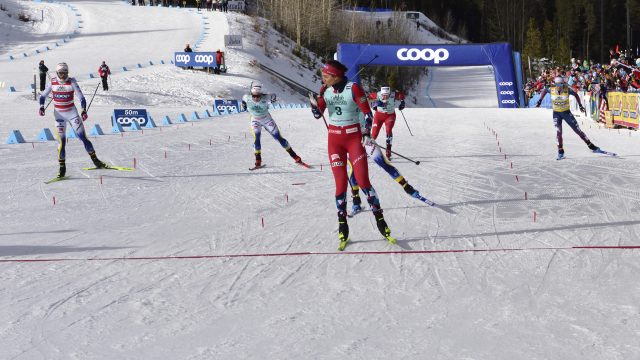
In the women’s field, the day would end in a drag race with Kristine Stavaas Skistad (NOR) proving that her top speed is unmatched (and playfully taunting her rivals at the finish line just to drive home the point). Skistad would take the victory ahead of Maja Dahlqvist (SWE) and Linn Svahn (SWE).
Qualifying
Top women’s qualifiers included Jonna Sundling (SWE) first, Svahn second, Skistad third. Among Americans, Jessie Diggins qualified sixth, Rosie Brennan 15th, Julia Kern 17th, Lauren Jortberg 20th, and Erin Bianco 25th, Alayna Sonnesyn 39th, Renae Anderson 40th, Emma Albrecht 46th, Alexandra Lawson 49th, Sydney Palmer Leger, 50th, and Michaela Keller-Miller 54th.
Among Canadians, Katherine Weaver qualified 35th, Anna Parent 41st, Anna Stewart 42nd, Olivia Bouffard-Nesbitt 48th, Elle-Ann Tremblay 51st, and Maeve McCleod 53rd.
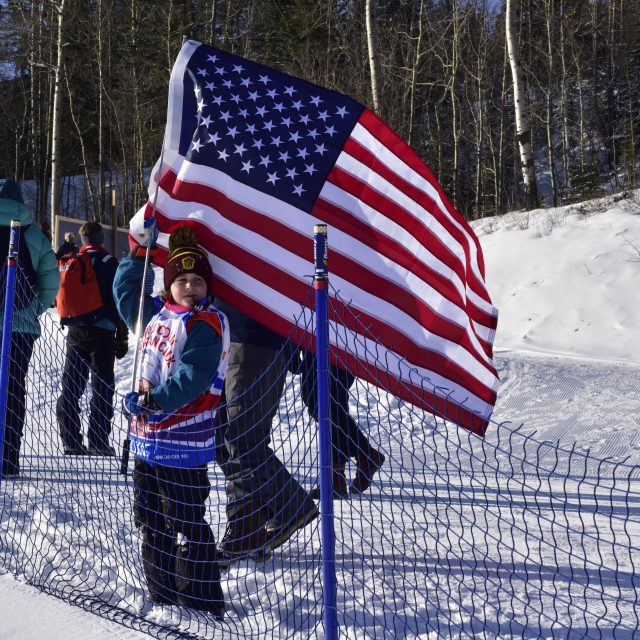
American men qualified six racers into the heats: JC Schoonmaker fifth, Jack Young 11th, Ben Ogden 22nd, Logan Diekmann 24th, KevinBolger 26th, Gus Schumacher 27th. Other American qualifiers included Will Koch 35th, Murphy Kimball 41st, Zak Ketterson 44th, Luke Jager 46th, Zanden McMullen 47th. Having so many Americans in the heats could hardly have happened before today, since the USA can usually not even enter six racers into the heats. It became possible in Canmore because of the larger competitor allotment allowed to host nations (Canada and USA), and the American men stepped up to fill the spots they had been given! Ultimately, only Ogden would advance beyond the quarterfinals; he would narrowly miss making the final.
Canadian sprinter, Pierre Grall-Johnson would qualify in 19th. He was followed by his countrymen: Xavier McKeever 32nd, Leo Grandbois 34th, Ry Prior 37th, Julian Smith 40th, Remi Drolet 49th, Julien Locke 52nd, Erikson Moore 53rd, Xavier Lefebvre 54th, and Felix-Olivier Moreau 55th.
Women’s Quarterfinals
Sundling and Skistad shared the first quarterfinal where both would successfully advance. Americans, Jortberg and Bianco, were fourth and fifth in quarterfinal 2, being eliminated after the calculation of lucky loser times. Brennan skied in the third quarterfinal that slowed almost to a stop at the top of the climb. Things would be settled after the downhill, where the drag race in the finishing straightaway left Brennan in sixth.
Diggins and Kern contested quarterfinal 5 where they would meet Heidi Weng (NOR), Tiril Udnes Weng (NOR), and Frida Karlsson (SWE). As she has done throughout the season. Diggins went straight to lead, and pressed the pace. Diggins strategy gapped Kern and H. Weng almost immediately, through T. Weng was able to stick to Diggin’s ski tails. Diggins’ fast pace created by far the fastest of the quarterfinals, and rewarded Kern and Karlsson with lucky loser spots.
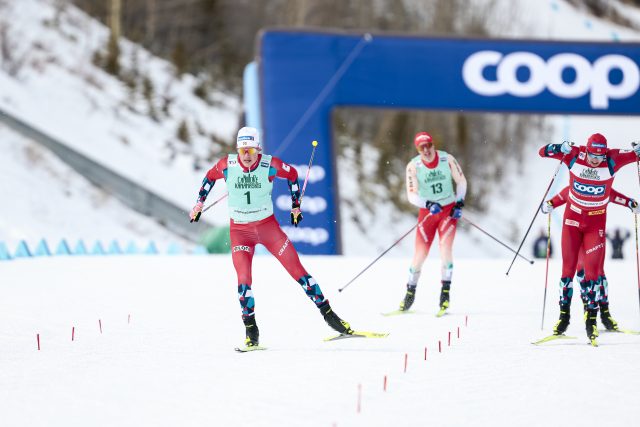
Men’s Quarterfinals
Klaebo and Chanavat squared off in quarterfinal 1, but it was definitely not business as usual. Chanavat usually goes straight to the front to set the pace: not today. In Canmore he chose to shadow Klaebo who was only too happy to allow Andrej Czerny (CZE) to set the pace. Predictably, Klaebo slingshotted past Czerny on the downhill with Chanavat in tow. They crossed the line first and second, just ahead of Diekmann whose third-place time, ultimately, would not hold up as a lucky loser.
Ogden shared quarterfinal 2 with Federico Pellegrino and Haavard Solaas Taugboel. Pellegrino tumbled out of contention on the final downhill, allowing Ogden to come around Taugboel to steal the heat win, and advance to the semifinals.
Schoonmaker and Schumacher shared Quarterfinal 4, averting early disaster as Schoonmaker got a replacement pole after breaking his in the opening meters of the heat. Fortunately for Schoonmaker, the pace of the later quarterfinal heats was so tactically slow that he was able to grab a new pole and get right back in the mix without expending more energy. Schumacher ended up in a photo finish with Schoonmaker for fourth and fifth. In the end, neither was fast enough to advance.
Collegiate skier, Jack Young, was living the dream in Canmore—qualifying 11th and lining up as the top qualifier in the fifth quarterfinal. Young skied calmly at the back of his heat—never rushed, never hurried. On a course that favored experienced veterans, Young played his cards well. In the end it just came down to raw speed as Young sprinted bravely, but finished fifth just behind the World Cup overall leader, Harald Oestberg Amundsen (NOR).
Women’s Semifinal
Svahn entered semifinal 1 where she would face Sundling, Skistad, Faehndrich, and Karlsson. At the bottom of the consequential downhill, Skistad bullied her way past Karlsson (who threw an elbow of her own), but it was Svahn who accelerated past for the semifinal win.
Jessie Diggins and Julia Kern lined up in semifinal 2. Diggins led early, and stomped on the accelerator at the top of the first climb, surprising everyone (including a visibly struggling Kern). It seemed that Diggins’ tactic was to get a gap that would negate the final downhill draft, and utilizing a technique of throwing her skis sideways at the top of the significant curve, allowing her to take a much tighter line around the turn. Her stability at speed allowed he to break into a skate at the back end of the turn (far earlier than her rivals), thereby regaining any speed she might have scrubbed a few meters before. Diggins free-skated across the line in first, ahead of T. Weng. Lucky losers, Hagstroem and Dahlqvist, also emerged from this fast semifinal.
Men’s Semifinal
Ogden paused visibly at the start of semifinal 1, allowing others to take the lead. The tactical advice on the day suggested that only the foolhardy would do so: Anger obliged. While Anger set the pace, Chanavat and Ogden vied for Klaebo’s tails. After the downhill, Klaebo and Chanavat managed to push past Anger, with Ogden was close behind in fourth (after being obstructed for a moment behind a tumbling Haeggstroem). It was a pretty fast heat: wait for the lucky loser determinations.
Janik Riebli (SUI) and Elia Barp (ITA) emerged from the second semifinal ahead of Valnes and Even Northug who claimed the lucky loser spots. Ogdens day was over. He would finish the day in seventh.
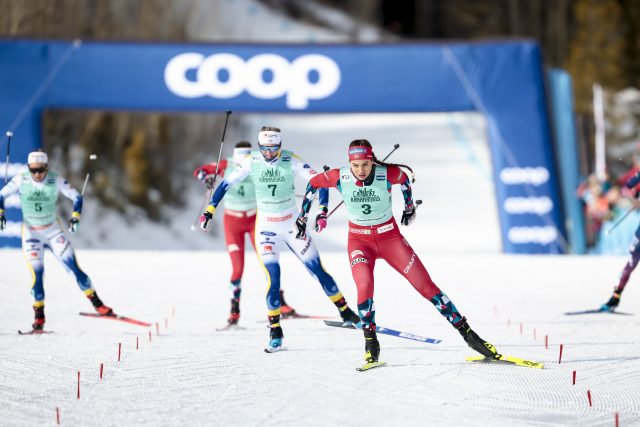
Women’s Final
Diggins lined up alongside Svahn, Skistad, Hagstroem, Dahlqvist, T. Weng. Skistad went to the front, then sat up. Diggins went to the back, and marked her rivals. No acceleration at the top of the first hill, no acceleration at the top of the second hill. Commentators described the pace as “pedestrian,” as the field crested the second hill in a five-across bunch. No one wanted the lead. It would be a drag race down the final hill and into the finish.
Ultimately, Skistad put her tremendous top speed on display, powering past everyone in the finishing straight, creating daylight between herself and runner-up Dahlqvist (toward whom Skistad turned to blow a kiss at the finish line—the Norway-Sweden rivalry is definitely real). Svahn finished third ahead of Hagstroem in fourth. Diggins picked up speed on the downhill and freeskated most of the finishing straight, but her top end was no match for the world’s best sprinters. She would finish fifth.
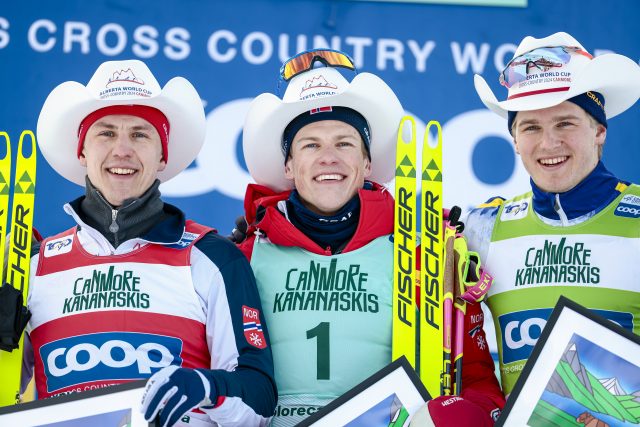
Men’s Final
Anger went to the lead of the Men’s Final (as he had in the semifinal) marked by Klaebo and Valnes, but by the top of the second hill, all had slowed to a crawl. The usually smoking downhill was a wait-and-see affair. Klaebo stood straight up through the right hand bend, baiting his rivals, only to dash away at the bottom of the curve. His strategy seemed to be that with the drafting portion of the hill behind them, his greater speed and superior agility in acceleration would carry him to the finish line first. In both assumptions, he proved correct. Valnes stumbled briefly as the entered the finishing straight, so Klaebo was not to be denied. Valnes recovered to finish second ahead of Anger in third.
Canmore World Cup Freestyle Sprints, WOMEN’S RESULTS
Canmore World Cup Freestyle Sprints, MEN’S RESULTS
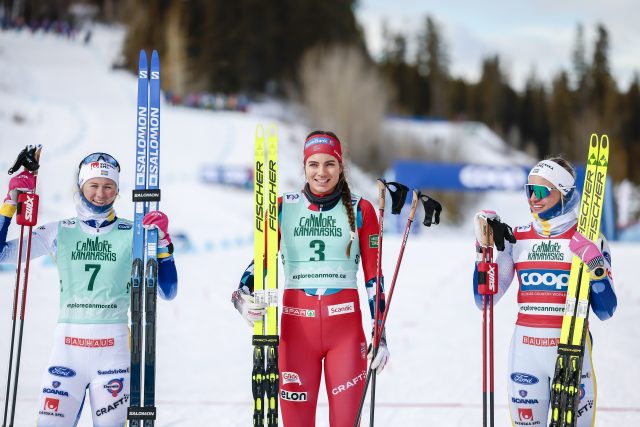
John Teaford
John Teaford—the Managing Editor of FasterSkier — has been the coach of Olympians, World Champions, and World Record Holders in six sports: Nordic skiing, speedskating, road cycling, track cycling, mountain biking, triathlon. In his long career as a writer/filmmaker, he spent many seasons as Director of Warren Miller’s annual feature film, and Producer of adventure documentary films for Discovery, ESPN, Disney, National Geographic, and NBC Sports.



